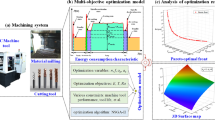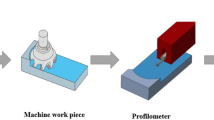Abstract
Some important parameters of the machine tool layout have to be selected in the early stages of design when a shortage of information makes application of the finite element method impractical. As a computer-aided tool in these stages, the form-shaping function (FSF)-based approach can be used. It allows evaluation of the kinematic and geometric errors and compliance issue static deformations, which contribute significantly to the total machining error as applied to precision machine tools. The FSF-based methodology gives important information allowing layouts’ comparison and structure optimization under uncertainty in requirements and limitations relating to the designed machine under strong time constraints. Six different layouts of a turning center are investigated to compare the effect of geometrical errors and compliance of machine structure on part accuracy in the range of less than five microns. Motion errors of machine tool components were measured by laser equipment during machine tool assembly and inspection. Compliance-induced errors are included in the evaluation to take into consideration cutting forces. Obtained data were used as the input for simulation of machining a sample workpiece—a sphere whose size, position, and form errors are used as criteria for layout comparison. Since the FSF-based results correlate well with the experimental data, the developed approach can be considered as an effective tool for application in the early stages of machine design.
Similar content being viewed by others
References
Rivin EI (2010) Handbook on stiffness & damping in mechanical design. ASME Press, New York, NY
Reshetov DN (ed) (1972) Elements and mechanisms of machine tools, vol 1. Mashinostroenie, Moscow
Homann B.S., Thornton A.C., 1998, Precision machine design assistant: a constraint-based tool for the design and evaluation of precision machine tool concepts, artificial intelligence for engineering design, analysis and manufacturing: AIEDAM, 12 (5), pp. 419–429.
Yu Z, Nakamoto K, Ishida T, Takeuchi Y (2010) Study on an interactive system for conceptual and basic design of machine tool structure. Journal of Advanced Mechanical Design, Systems and Manufacturing 4(5):795–805
Chen W, Luo X, Su H, Wardle F (2016) An integrated system for ultra-precision machine tool design in conceptual and fundamental design stage. Int J Adv Manuf Technol 84(5–8):1177–1183
Slocum AH (1992) Precision machine design. Prentice Hall Englewood Cliffs, NJ
Martin P, Dantan JY, D’Acunto A (2011) Virtual manufacturing: prediction of work piece geometric quality by considering machine and set-up accuracy. International Journal of Computer Integrated Manufacturing 24(7):610–626
Bamberg E. (2000) Principles of Rapid Machine Design, PhD diss., Massachusetts Institute of Technology
Pascal M (2012) Parallelization of design and simulation: virtual machine tools in real product development. PhD diss, ETH Zurich
Schlesinger G (1966) Testing of machine tools, 7th edn. Machinery Publishing Co, Ltd
Kushnir E (2013) Super-precision turning center: high accuracy hard turning. Multi-Tool Machine Tool, ASPE annual meeting 56:273–276
Yang J, Mayer JR, Altintas Y (2015) A position independent geometric errors identification and correction method for five-axis serial machines base on screw theory. Int J Mach Tools Manuf 95:52–66
Ramesh R, Mannan MA, Poo AN (2000) Error compensation in machine tools—a review. Part 1: Geometric, cutting-force induced and fixture-dependent errors International Journal of Machine Tools and Manufacture 40:1235–1256
Tian W, Gao W, Zhang D, Huang T (2014) A general approach for error modeling of machine tools. Int J Mach Tools Manuf 79:17–23
Hocken R. (ed) (1980) Machine tool accuracy, in.: Technology of Machine Tools, Vol. 5, Department of Commerce UCRL-52960-5
Soons JA, Theuws FC, Schellekens PH (1992) Modeling the errors of multi-axis machines: a general methodology. Precis Eng 14(1):5–19
Okafor AC, Ertekin YM (2000) Derivation of machine tool error models and error compensation procedure for three axes vertical machining center using rigid body kinematics. Int J Mach Tools Manuf 40:1199–1213
Wilhelm RG, Srinivasan N, Farabaugh F (1997) Part form errors predicted from machine tool performance measurements. CIRP Annals-Manufacturing Technology 46(1):471–498
Faux ID, Pratt MJ (1979) Computational geometry for design and manufacture. John Wiley, New York, NY
Denavit J, Hartenberg RS (1955) A kinematic notation for lower-pair mechanisms based 0n matrices, trans. ASME. J Appl Mech 23:215–221
Díaz-Tena E, Ugalde U, López de Lacalle LN, de la Iglesia A, Calleja A, Campa FJ (2013) Propagation of assembly errors in multitasking machines by the homogenous matrix method. Int J Adv Manuf Technol 68:149–164
Olvera D, López de Lacalle LN, Compeán FI, Fz-Valdivielso A, Lamikiz A, Campa FJ (2012) Analysis of the tool tip radial stiffness of turn-milling centers. Int J Adv Manuf Techno 60:883–891
Reshetov DN, Portman VT (1988) Accuracy of machine tools. ASME Press, New York, NY
Kushnir E, Portman VT 1991 Structural synthesis of calculation models of machine tool mechanics, Russian Engineering Research, Vol. 62, No. 9, Allerton Press, pp. 64–69
Portman VT, Inasaki I, Sakakura M, Iwatate M (1998) Form-shaping systems of machine tools: theory and applications. Annals of the CIRP 47(1):329–332
Portman VT, Shneor Y, Chapsky VS, Shapiro A (2015) Form-shaping function theory expansion: stiffness model of multi-axis machines. International Journal Advanced Manufacturing Technology 76(5):1063–1078
Inasaki I, Kishinami N, Sakamoto Y, Sugimura FT (1997) Shape generation theory for machine tools. Yokendo, Tokio (in Japanize)
Lee RS, Lin YH (2012) Applying bidirectional kinematics to assembly error analysis for five-axis machine tools with general orthogonal configuration. Int J Adv Manuf Technol 62:1261–1272
Caia L, Zhanga Z, Chenga Q, Liua Z, Guc P, Qi Y (2016) An approach to optimize the machining accuracy retainability of multi-axis NC machine tool based on robust design. Precis Eng 43:370–386
Koenigsberger F, Tlusty J (1970) Machine tool structures, vol 1. Pergamon Press, Oxford
Kushnir E, Sheehan T 2003 Development of machine tool structure at the early stages of design process. Proc. ASME 2003 International Mechanical Engineering Congress and Exposition, Recent Advances in Mechanics of Solids and Structures, Washington, DC, USA, pp. 121–127
Urbikain G, Campa F-J, Zulaika J-J, López de Lacalle L-N, Alonso M-A, Collado V (2015) Preventing chatter vibrations in heavy-duty turning operations in large horizontal lathes. J Sound Vib 340:317–330
THK Co., 2016 Linear Motion Systems (509-1E edition). Japan
Bryan JB (1979) The Abbe principle revisited: an updated interpretation. Precis Eng 1(3):129–132
INA, Schaeffler Group (2008) Monorail guidance systems, March 2008 ed., Germany
Author information
Authors and Affiliations
Corresponding author
Rights and permissions
About this article
Cite this article
Kushnir, E., Portman, V., Aguilar, A. et al. Layout evaluation at earlier stages of machine tool design:form-shaping function-based approach. Int J Adv Manuf Technol 90, 3333–3346 (2017). https://doi.org/10.1007/s00170-016-9667-0
Received:
Accepted:
Published:
Issue Date:
DOI: https://doi.org/10.1007/s00170-016-9667-0




